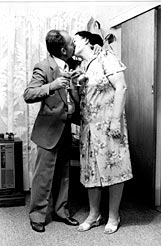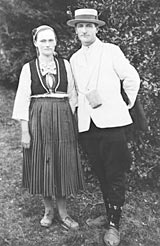
|
| A 25th anniversary kiss |
Ruza & Bozidar recall Serbian wedding traditions
Author: Megan Wynne-Jones, Getting Married project
Getting Married: Ruza & Bozidar, originally from Serbia, have been living in Australia for forty years. Their own marriage in Serbia was a simple civil ceremony, but they remember and recount the many rituals and traditions of weddings they attended in their homeland.
An interpreter was used for this story.
Bozidar and Ruza get married
Ruza and Bozidar were married in a registry office in Serbia in 1956, in what
Bozidar calls a “shortcut” wedding, a simple ceremony with two witnesses,
the best man and the kum or godparent. Both aged 24, they had met at
a dance in their village of Sabor, where Bozidar was playing as the drummer
in the band. Ruza told her mother she was determined to marry Bozidar, and soon
after they met, Bozidar went to Ruza's house and asked her father's
permission to marry her. Their parents agreed, so the wedding could go ahead
and was planned to take place in two weeks.
Although Ruza and Bozidar did not experience the traditional Serbian wedding,
they are well accustomed with the traditions.
Meeting and matchmaking
 |
 |
|
(Bozidar) Normally the young people would meet each other,
and if they fall in love, the parents have to give permission. The parents ask
their son about the girl and find out what sort of family she comes from, and
the girl gets the same question from her parents. If both the parents agree,
then they meet and talk and make the marriage arrangements. Sometimes it happens
that one parent agrees and the others don't. Sometimes a matchmaker is brought
in, someone who knows both families.
|
Before the wedding
The formal engagement happened at the girl's home, where presents were
exchanged and plans made for the wedding. Traditionally the groom would pay
for the wedding, including the bride's dress and shoes, and for the party.
A few days or a week before the wedding, an ibrik or drinking vessel
is filled with sljivovica or plum brandy and sent door to door by a
special wedding attendant, to invite guests to the wedding.
Ruza remembers helping to get brides ready for their weddings in her village.
She would help with their hair and with dressing them. On the day, the girl
would be at her parent's place with relatives and guests. She has already
put her possessions into a decorated bullock cart which is taken to the groom's
place.
Bozidar recalls that an apple on a stick is placed up high in a tree and the
groom has to come and shoot the apple down with a gun.
 |
 |
|
This is to gain the rights to see the girl. If the groom misses
the apple, then he's not going to get married.
|
At the church
Once the apple has been shot down, a small party is held and the bride gets
ready to go to the church or registry office, accompanied by the local brass
band. The bride's brother or a close relative takes the bride into the
church.
 |
 |
|
Traditionally the groom is not allowed to touch the bride. The
first time the couple touch is in the church when their hands are wrapped together
by the sash.
|
The brother or friend of the groom holds the flag and stays with the bride
all the way through the wedding and the reception. The godparents (kum,
kuma) have special significance at the wedding.
 |
 |
|
The godfather or godmother and their family are very respected
people in your life, from the christening onwards. The tradition is that the
godparents stay in the same family, from generation to generation. At a wedding
their duty is as a witness, together with the best man. They are special guests.
|
The wedding party
The wedding party is traditionally held at the groom's place. The mother
of the groom is waiting at the door which has been anointed with butter and
honey. As a welcome, before the bride enters, the mother-in-law blesses her
with an apple and wheat and with money, for luck and health. A sash is stretched
across the doorway and the couple have to jump over it to enter the house. Whoever
leaps the furthest will, traditionally, rule the marriage.

Ruza's parents
Bozidar and Ruza remember witnessing the handing out of sprigs of rosemary,
flowers, flags or ribbons to the guests. In return, the guests would put flowers
and money in a tray. According to Bozidar, the presence of a young male baby
for good luck and as a blessing to have children, is a regional custom, not
practiced everywhere in Serbia. In some places the bride has to grab and toss
the child in the air three times.
Another custom practiced in some regions is the stealing of the bride's
shoes. An auction is then held to see who will pay the most to buy them. The
money goes to the bride and groom.
Food provided at the wedding would have depended on the wealth of the family.
There may be roast pig or calf roasted on a spit outside. There would be pitta
(cheese pies), generally the best food that can be prepared. Sljivovica
is served, but no special wedding cake.
Once the wedding party is over, guests would leave only after the wedding host
or stari svat leaves.
 |
 |
|
In my village the best man would say, in the middle of winter,
that he's not going home until you bring him a hawthorne in flower. This means
waiting three or four months! So people would pop corn and place it on a hawthorne
branch and say, ‘alright best man, here is a hawthorne in flower!'
|
The day after
Once everyone has gone home, the celebrations are not yet done. The next day,
there is another party to which the bride's parents, as well as relatives
and friends, are invited. Close family members are given presents by the bride
and groom, depending on what they can afford. It might have been socks, a scarf
or a shirt. Nowadays it might even be a TV or a washing machine. At this party,
sljivovica is served from an ibrik, this time heated up. Two
weeks later there is another party, this time at the bride's parents'
place. Traditionally, there is no honeymoon for the couple; they go home and
begin their married life straight away.
Bozidar and Ruza's long marriage
After spending three years in Europe trying to migrate, Bozidar arrived in Australia
in 1959, at first living in Tasmania and then moving to Cooma in NSW where he
worked on the Snowy Mountains scheme. Ruza, who had stayed behind in Serbia,
was able to join him in 1963, bringing their young son Marinko. Soon after settling
in the Cooma district they had their second son, Dragoslav. In 1968 they moved
to Cabramatta in Sydney's west, where their daughter Ljiljana was born,
and they have been living ever since. Married for 47 years and with three adult
children, Bozidar and Ruza say that mutual love and respect has been the cornerstone
of their enduring relationship.
>
Back to Dragana & Jadranko's wedding
> Take a look at some more weddings
|


